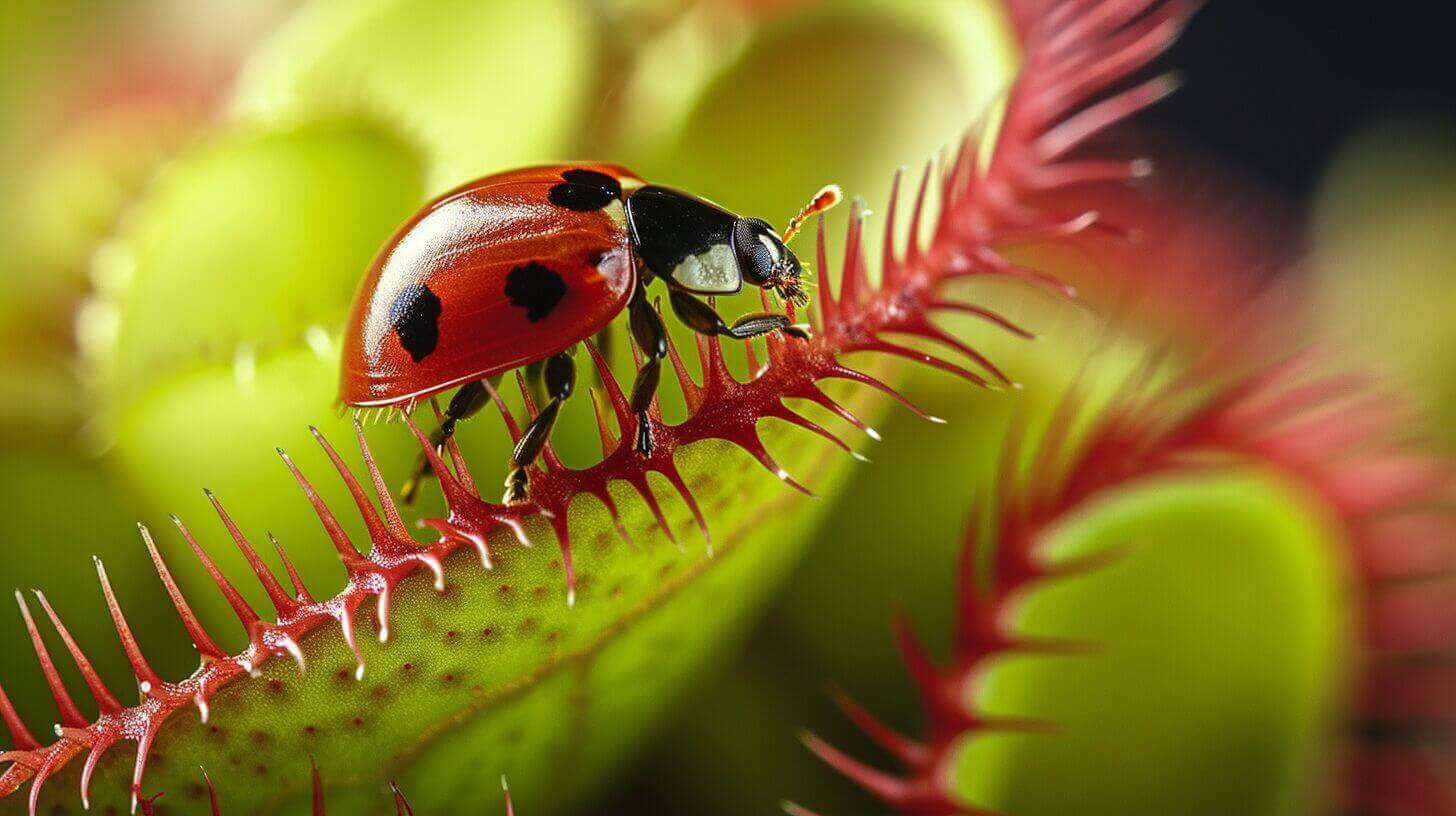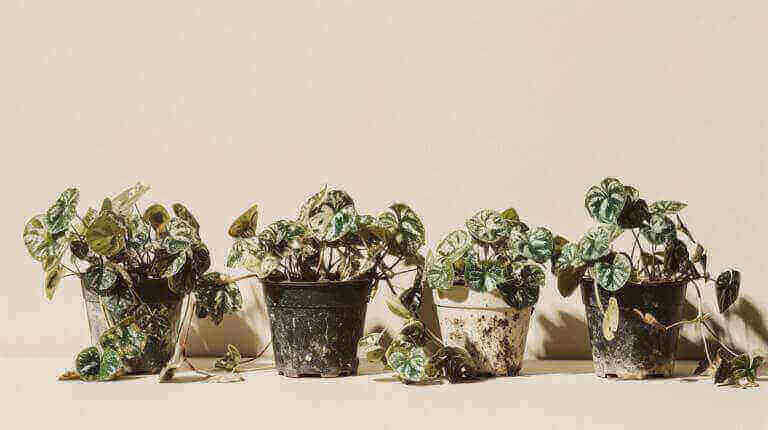What Can Venus Fly Trap Eat? Safe Bugs and How Much to Feed Them
As a proud owner of a Venus flytrap, you may be wondering what you should feed this intriguing carnivorous plant. Growing carnivorous plants such as Venus flytraps are fascinating creatures that rely on catching their own food if they are kept outdoors. They can catch flies, spiders, ants, and other small bugs to sustain themselves. However, if you have an indoor plant or simply want to take an active role in feeding your Venus flytrap, there are some important guidelines to follow.
Key Takeaways:
- Stick to a Venus flytrap’s natural diet of bugs and avoid feeding them human food.
- Avoid fertilizers or regular plant food, as Venus flytraps prefer nutrient-poor soil.
- Feed them one trap per week to prevent overfeeding and exhaustion.
- Ensure that the food is not larger than 1/3 the size of the trap to avoid damage and rotting.
- If using dead bugs, simulate live prey by gently touching the trigger hairs after the trap has closed.
What Are the Best Foods for Venus Flytraps?
Venus flytraps have very specific dietary needs and thrive on a diet of small insects. The best foods for Venus flytraps include mealworms, bloodworms, and crickets. These options provide the necessary nutrients and are widely available for carnivorous plant growers.
Mealworms are a popular choice as they are small freeze-dried worms that can be easily rehydrated with a few drops of water before feeding. They are a nutritious food source for flytraps and can be purchased from pet shops or reptile specialists.
Bloodworms, despite their name, are also a great option for feeding Venus flytraps. These tiny freeze-dried worms offer a convenient and nutritious food source. They can be found in pet shops or aquariums and should also be rehydrated before feeding.
Crickets, when small enough, can be an excellent snack for adult Venus flytraps. They can be purchased as dried crickets and should fit entirely into the trap without preventing a complete seal. This ensures the health and well-being of the plant.
| Food | Description | Availability |
|---|---|---|
| Mealworms | Small freeze-dried worms | Widely available in pet shops or reptile specialists |
| Bloodworms | Tiny freeze-dried worms | Can be found in pet shops or aquariums |
| Crickets | Dried crickets | Available from various sources |
These foods are not only suitable for Venus flytraps indoors but also for other carnivorous plants such as sundews, butterworts, and pitcher plants. Bloodworms are especially ideal for these plants, while mealworms and crickets can also be beneficial for larger pitcher plants.
Feeding Venus flytraps with the best foods ensures they receive the necessary nutrition for optimal growth and health. Mealworms, bloodworms, and crickets are nutritious options that can be easily obtained and prepared for feeding. These choices provide a balanced diet and support the well-being of not only Venus flytraps but also other carnivorous plants.
How Often Should You Feed a Venus Flytrap?
Feeding a Venus flytrap is an essential part of its care routine, as it provides the necessary nutrients for healthy growth. However, it is crucial to strike the right balance when it comes to feeding frequency. Overfeeding can lead to digestive issues and slow growth, while underfeeding can deprive the plant of the nutrients it needs. So, how often should you feed a Venus flytrap?
The frequency of feeding a Venus flytrap depends on several factors, including the growing season and the health of the plant. During the growing season, which typically lasts from spring to fall, it is generally recommended to feed a Venus flytrap once a week. This frequency allows the plant to receive regular nourishment without overwhelming its digestive system. Feeding two traps per plant once a week is considered sufficient to provide the necessary nutrients without overfeeding.
However, it is important to note that Venus flytraps are capable of catching their own prey if grown outdoors, and do not necessarily need live food. They can rely on natural prey like flies, spiders, ants, and other small bugs. Feeding them live insects can provide stimulation and contribute to their overall health, but it is not a requirement.
When feeding a Venus flytrap, it is essential to ensure that the size of the food is no larger than one-third the size of the trap. This helps to avoid rotting and damaging the trap. If using a dead bug for feeding, gently touching the trigger hairs after the trap has closed can help stimulate the movement of live prey and initiate digestion.
| Feeding Frequency | Benefits |
|---|---|
| Daily Feeding | Stimulates traps and trigger hairs |
| Occasional Feeding | Provides necessary nutrients without overfeeding |
What Foods Should You Avoid Feeding Venus Flytraps?
When it comes to feeding your Venus flytraps, it’s important to stick to their natural diet of bugs and avoid feeding them human food. Chocolate and chicken are not part of their natural diet and can harm the plant, so it’s best to steer clear of these foods. Additionally, flytraps prefer to grow in nutrient-poor soil, so it’s important to avoid giving them fertilizers or regular plant food.
Feeding your Venus flytraps with prey that is too large can also cause problems. It’s recommended to feed them prey that is no larger than 1/3 the size of the trap to avoid the trap from rotting and damaging the plant. If you’re using dead bugs to feed your flytrap, it’s necessary to simulate live prey by gently touching the trigger hairs with a toothpick or cocktail stick after the trap has closed to ensure digestion starts.
By avoiding human food, fertilizers, and large prey, you can keep your Venus flytraps healthy and ensure their traps remain undamaged. Stick to their natural diet of bugs, simulate live prey when using dead bugs, and provide the right-sized prey to keep them thriving.
Summary:
- Avoid feeding Venus flytraps human food like chocolate and chicken, as it is not part of their natural diet and can harm the plant.
- Do not give them fertilizers or regular plant food, as they prefer to grow in nutrient-poor soil.
- Feed prey that is no larger than 1/3 the size of the trap to avoid rotting and damaging the plant.
- When using dead bugs, simulate live prey by gently touching the trigger hairs after the trap has closed to ensure digestion starts.
Can Venus Flytraps Be Fed With Live Food?
Feeding Venus flytraps live food can be a challenging endeavor due to the difficulty in preventing the insects from escaping. Mealworms, for example, have been known to burrow out of the traps, while crickets are quick and can easily evade capture. However, there are methods to make feeding live prey more manageable.
One option is to stun live crickets before offering them to the carnivorous plants. Placing the container of crickets in the freezer for several minutes will immobilize the insects, making them easier to handle and ensuring they remain within the trap boundaries. This technique can help prevent the frustration of crickets escaping.
Alternatively, dried mealworms provide a convenient and widely available food source for Venus flytraps. These dehydrated worms offer similar nutritional benefits to live mealworms but are less likely to escape or cause other feeding-related issues. The availability and simplicity of using dried mealworms make them a popular choice among growers.
Tips for Proper Feeding of Venus Flytraps
Feeding Venus flytraps properly is crucial for their growth and overall health. Whether you choose to provide live prey or simulate the struggle of live prey, here are some essential techniques to ensure your flytraps receive the nutrition they need:
1. Stimulate Trigger Hairs: To trigger the trap, use a toothpick or tweezers to gently touch the trigger hairs inside the trap. This simulates the movement of struggling prey and prompts the trap to close.
2. Feeding Young Flytraps: Feeding young Venus flytraps can significantly boost their growth and development. Make sure to use prey that is the appropriate size for their traps, so they can effectively capture and digest their food.
3. Alternative Food Options: Aside from live prey, you can also feed your Venus flytraps with betta fish pellets, bloodworms, or mealworms. These options provide essential nutrients and are convenient alternatives to live insects.
Remember, it’s important to avoid overfeeding your flytraps. Feed only 2 traps per plant once a week at the most to prevent damage and allow for proper digestion. Also, refrain from feeding Venus flytraps during their dormancy period, as they do not require food during this resting stage.
Properly feeding your Venus flytraps ensures their optimal health and growth. Use the techniques mentioned above, provide the right prey or alternative food options in the correct size, and maintain a balanced feeding schedule to keep your flytraps thriving.
FAQ
What is a carnivorous plant?
A carnivorous plant, like the Venus flytrap, is a plant that derives some or most of its nutrients from trapping and consuming animals or protozoans, typically insects and other arthropods.
What should I never feed my Venus flytrap?
You should never feed your Venus flytrap any food that is not alive. This includes processed foods like hamburger meat or non-insect sources. These can cause the traps to turn black and die.
What do Venus flytraps eat?
Venus flytraps eat a variety of small insects. They can consume beetles, caterpillars, slugs, and even small spiders. The insect must be alive when it triggers the hairs inside the trap, causing it to close.
How often should I feed my Venus flytrap?
Venus flytraps don’t need to be fed if they are kept outdoors where they have access to their natural food source of insects. If kept indoors, feeding your Venus flytrap a small insect every two to three weeks is sufficient.
What are some tips for growing carnivorous plants?
Growing carnivorous plants like Venus flytraps requires specific conditions. They need a lot of light, prefer rainwater or distilled water, and require a specific type of soil, usually a mix of sphagnum moss and perlite.
What is the main food source for Venus flytraps?
The main food source for Venus flytraps is small insects. The plant’s traps snap shut when an insect touches the trigger hairs located on the inner surface of the lobe of the trap.
What is the International Carnivorous Plant Society?
The International Carnivorous Plant Society is an organization dedicated to the study and conservation of carnivorous plants. They provide a wealth of information on plant care, including how to feed your plants and keep your Venus flytrap healthy.
What do Venus flytraps need to survive?
Venus flytraps need plenty of light, the right type of soil (usually a mix of sphagnum moss and perlite), and a specific watering regimen (preferably with rainwater or distilled water). They also require a winter dormancy period to mimic their natural habitat.







